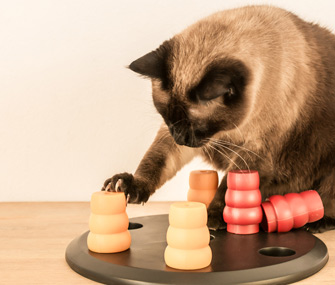[ad_1]

Thinkstock
Not sure about food puzzles? In Dr. Tony Buffington’s experience, most pets can learn to use and enjoy them.
Some veterinarians recommend using puzzles to deliver a portion of a pet’s daily food to confined cats and dogs. But what if you are not sure if food puzzles are such a good idea for your pet? Or what if you’re not sure your pet will use one or you think they look like too much work? I am here to tell you that the payoff for your pet is tremendous and well worth any extra work.
In my years of working with pets and their owners, I have come up with a number of ways to “troubleshoot” food puzzle problems. Here are some common concerns about food puzzles and how I address them with my clients.
1. “My pet doesn’t need a food puzzle.”
I hear this mostly from clients who are unfamiliar with food puzzles and are used to feeding their pets from a bowl exclusively. How do I try to convince these owners to give puzzles a try? First, I am not here to pressure anyone. I know this is something that many owners often have to “feel” their way into trying, so I instead use gentle encouragement. I’ll point out that many clients feel this way initially but ultimately find that food puzzles can provide many benefits to their beloved pets if they try them. I remind them that dogs and cats are hunters by nature — an activity we deprive our pets of when we keep them confined. We can return this activity to them with food puzzles and, in my experience, most dogs and cats enjoy them when the puzzles are properly chosen and introduced. If an owner still doesn’t want to try one, I try to leave the door open for more conversation and questions later if he or she reconsiders.
2. “My pet won’t use a food puzzle.”
In my experience, most pets can learn to use and enjoy food puzzles, including aged pets and pets with disabilities. I hear this objection both from owners who have not tried food puzzles and from those who have tried and failed with them. For those of you who have not tried to use one yet, there are many different kinds of food puzzles available — just ask your veterinarian for some recommendations. Start by choosing puzzles (movable or stationary) based on your pet’s preferences, characteristics (such as quickness to learn and chewing strength, especially in dogs) and your cost preferences (food puzzles can be inexpensive and homemade or more expensive ones bought in stores).
For clients who have tried and failed, we can look at several possibilities. Maybe we chose the wrong puzzle to try and the pet just didn’t like it or found it too hard to use and figure out. Another possibility is that the puzzle was maybe offered at the wrong time (e.g., not at meal time when the pet was hungry and motivated to learn what it was). Or the puzzle might have been offered in the wrong situation, such as when there was a lot of distracting activity in the household, like the presence of other pets, children or people. Once we identify a possible problem, we can try again!
3. “I don’t want to prepare food puzzles daily.”
This problem is easy to address. Some puzzles require no more work than placing food in a bowl or you can get several different kinds of food puzzles and rotate them on a regular basis to further stimulate your pet’s interest. You can easily prepare a few days’ or even a week’s worth of food puzzles at one time. Just be sure to store them in a cool place in an airtight container. If a perishable food item is used, make sure to store the puzzle in your refrigerator or freezer based on what the item is.

